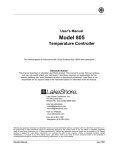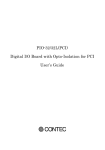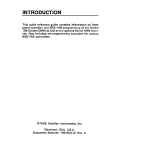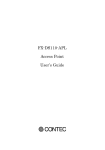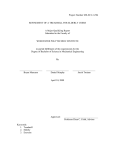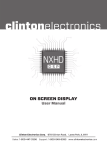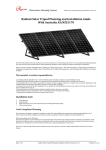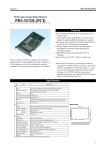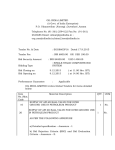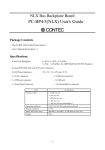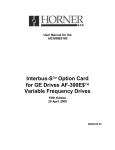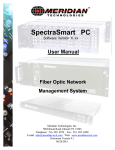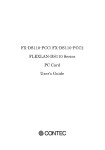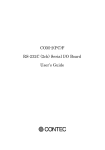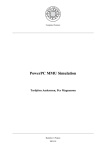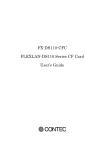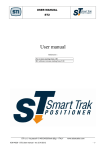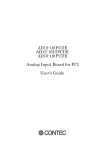Download CNT24-4D(PCI) 24Bit Differencial Up/Down Counter Board for PCI
Transcript
CNT24-4D(PCI) 24Bit Differencial Up/Down Counter Board for PCI User’s Guide Copyright Copyright 2000 CONTEC Co., LTD. ALL RIGHTS RESERVED No part of this document may be copied or reproduced in any form by any means without prior written consent of CONTEC Co., LTD. CONTEC Co., LTD. makes no commitment to update or keep current the information contained in this document. The information in this document is subject to change without notice. All relevant issues have been considered in the preparation of this document. Should you notice an omission or any questionable item in this document, please feel free to notify CONTEC Co., LTD. Regardless of the foregoing statement, CONTEC assumes no responsibility for any errors that may appear in this document nor for results obtained by the user as a result of using this product. Trademarks MS, Microsoft, MS-DOS and Windows are trademarks of Microsoft Corporation. Other brand and product names are trademarks of their respective holder. CNT24-4D(PCI) i Product Configuration - CNT24-4D(PCI) Board…1 - CNT24-4D(PCI) SETUP DISK (3.5inch/1.44MB) …1 - User’s Guide (this booklet)…1 Unpacking: This board is specially packed in an anti-static bag to prevent damage in shipping. Check the contents to make sure that you have everything listed above. If you do not have all the items, contact your distributor or CONTEC group office where you purchased. Note! Do not remove the board from its protective packaging until the computer case is open and ready for installation. Electrical static can cause damage to electrical components. ii CNT24-4D(PCI) Table of Contents Copyright ............................................................................i Trademarks ........................................................................i Product Configuration ..................................................... ii 1. Introduction ............................................................. 1 Features.........................................................................1 Limited Three-Year Warranty......................................2 How to Obtain Service..................................................2 Liability .........................................................................2 Handling Precautions...................................................3 About the Manual .........................................................4 2. Component Locations and Setting .............................. 5 Component Locations........................................................5 Setting the Board ID.........................................................6 Setting Procedure .........................................................6 Setting One-shot Pulse Output Signals...........................7 Setting Terminators ..........................................................8 3. Board Setup ............................................................. 9 Use CONTEC Windows Software Products.....................9 When Not Using CONTEC Software for Windows .......10 For Windows 98 Systems............................................10 For Windows 95 Systems............................................14 For other OS systems .................................................19 4. Connection with External Devices ............................ 21 Interface Connector.........................................................21 Connecting the Interface Connector ..........................21 Interface-Connector Signal Assignment....................22 PCB96WS and CCB-96 Signal Assignment ..............23 Connection of External Signals......................................24 Line Receiver Input Circuit and an Example Connection...................................................................24 CNT24-4D(PCI) iii TTL-level Input Circuit and an Example Connection ......................................25 Output Circuit and an Example Connection.............25 Example Connection with a Rotary Encoder.................27 Measures against Voltage Surges ..................................28 5. I/O Port Bit Assignment .......................................... 29 I/O Port Bit Assignment .................................................29 Setting Data ................................................................30 Count Flow ......................................................................31 Operation Commands .....................................................32 Description of Output Commands..................................34 Initial Count Value (Command CH0:00H:, CH1:05H:, CH2:0AH:, CH3:0FH) .................................................34 Operation Mode (Command CH0:01H:, CH1:06H:, CH2:0BH:, CH3:10H) .................................................34 Each Counter Operating Mode ..................................36 Phase Z/CLR Input (Command CH0:02H, CH1:07H, CH2:0CH, CH3:11H)...................................................40 Compare Register (Command CH0:03H, CH1:08H, CH2:0DH, CH3:12H) ..................................................41 Digital Filter (Command CH0:04H, CH1:09H, CH2:0EH, CH3:13H) ..................................................42 Count Value Latch (Command 14H)..........................43 Interrupt Mask (Command 15H) ...............................44 Sense Reset (Command 16H) .....................................44 Programmable Timer (Command timer data:17H, Timer start:18H) .........................................................45 One-shot Pulse (Command 19H)................................46 General-purpose Input Signal Select (Command 1AH) .........................................................48 Description of Input Commands ....................................49 Count Read (Command CH0:00H, CH1:05H, CH2:0AH, CH3:0FH) ..................................................49 Status Data (Command CH0:01H, CH1:06H, CH2:0BH, CH3:10H) ..................................................49 Interrupt Mask (Command 15H) ...............................51 iv CNT24-4D(PCI) Sense Port (Command 16H) .......................................51 General-purse Input Signal Select (Command 1AH) .........................................................52 Initialization....................................................................53 6. Board Specifications................................................ 55 Block Diagram.................................................................55 Specifications...................................................................56 7. Index ..................................................................... 59 CNT24-4D(PCI) v List of Figures Figure 2.1. Component Locations............................................... 5 Figure 2.2. Board ID Settings (SW1).......................................... 6 Figure 2.3. Switch for setting one-shot-pulse output signals ....... 7 Figure 2.4. Terminator setting switches ...................................... 8 Figure 4.1. Connecting the interface connector ........................ 21 Figure 4.2. Connectors in use ................................................... 21 Figure 4.3. Interface-connector signal assignment .................... 22 Figure 4.4. PCB96WS and CCB-96 signal assignment ............. 23 Figure 4.5. Line-receiver input circuit and an example connection..................................... 24 Figure 4.6. TTL-level input circuit and an example connection 25 Figure 4.7. Open-collector output circuit and an example connection .............................................................. 26 Figure 4.8. TTL-level output circuit and an example connection26 Figure 4.9. Example connection with a rotary encoder (Line receiver input)............................................... 27 Figure 4.10. Example connection with a rotary encoder (TTL input) ............................................................ 27 Figure 4.11. Example measures against voltage surges............... 28 Figure 5.1. Output port ............................................................. 29 Figure 5.2. Input port ............................................................... 29 Figure 5.3. Count flow.............................................................. 31 Figure 5.4. Example counting during 2-phase input.................. 36 Figure 5.5. Example counting during single-phase input .......... 36 Figure 5.6. Example counting during single-phase input with gate control attached....................................... 37 vi CNT24-4D(PCI) Figure 5.7. Example counting during synchronous clear .......... 37 Figure 5.8. Example counting during asynchronous clear......... 38 Figure 5.9. Example counting when count input multiplication is set ....................................................................... 39 Figure 5.10. Phase Z enable frequency ZSEL=0 (Positive logic) ....................................................... 40 Figure 5.11. Digital filter............................................................ 42 Figure 6.1. Block Diagram ....................................................... 55 CNT24-4D(PCI) vii List of Tables Table 2.1. One-shot-pulse output signal settings.......................... 7 Table 2.2. Terminator settings...................................................... 8 Table 5.1. Output commands ..................................................... 32 Table 5.2. Input commands........................................................ 33 Table 5.3. Counter operation modes .......................................... 35 Table 5.4. Switching counting directions ................................... 35 Table 5.5. Phase Z input mode................................................... 40 Table 5.6. Digital filter clock settings ........................................ 43 Table 5.7. Relationship between programmable timer setting data and timer interrupt cycles.......................................... 46 Table 5.8. Relationship between specified one-shot-pulse width data and pulse widths ................................................ 47 Table 5.9. Initialized state.......................................................... 53 Table 6.1. Specifications............................................................ 56 viii CNT24-4D(PCI) Introduction 1. Introduction Thank you for purchasing the CONTEC CNT24-4D(PCI). The CNT24-4D(PCI) is a PCI bus-compliant interface that counts digital signals from an external device. This board should be inserted into a PC's PCI bus slot or PCI bus unit. Read this guide thoroughly before you build a system including creation of application programs and connection with external devices. Support software sold separately - Driver Software Package (Option) API-PAC(W32) Please follow the setup instructions of the User’s manual shipped with the software products and/or the help files of the package to setup our interface board(s) to your system. For details of CONTEC software products, please contact our sales agencies. Features - The PCI bus-compliant interface board can be used with the PC98 series or PC-AT (DOS/V machines) equipped with a PCI bus expansion slot. - This single board can count up and down 24 bits for four channels. - The board can count two-phase signals of a rotary encoder or linear gauge, for example. - The board allows you to select a photocoupler insulated input or TTL-level input for each channel. - The board can either generate interrupts or output signals when a count of each channel matches any specified value. - The board is equipped with a programmable timer to allow interrupts to be generated periodically according to a specified timer value. - The board is equipped with one general-purpose input signal for each channel (both photocoupler and TTL). CNT24-4D(PCI) 1 Introduction Limited Three-Year Warranty CONTEC Interface boards are warranted by CONTEC Co., LTD. to be free from defects in material and workmanship for up to three years from the date of purchase by the original purchaser. Repair will be free of charge only when this device is returned freight prepaid with a copy of the original invoice and a Return Merchandise Authorization to the distributor or the CONTEC group office, from which it was purchased. This warranty is not applicable for scratches or normal wear, but only for the electronic circuitry and original boards. The warranty is not applicable if the device has been tampered with or damaged through abuse, mistreatment, neglect, or unreasonable use, or if the original invoice is not included, in which case repairs will be considered beyond the warranty policy. How to Obtain Service For replacement or repair, return the device freight prepaid, with a copy of the original invoice. Please obtain a Return Merchandise Authorization Number (RMA) from the CONTEC group office where you purchased before returning any product. * No product will be accepted by CONTEC group without the RMA number. Liability The obligation of the warrantor is solely to repair or replace the product. In no event will the warrantor be liable for any incidental or consequential damages due to such defect or consequences that arise from inexperienced usage, misuse, or malfunction of this device. 2 CNT24-4D(PCI) Introduction Handling Precautions Take the following precautions when handling this board. - Never modify the board. The manufacturer cannot be responsible for any board that has been modified by the user. - Protect the board against shock and do not bend the board or it will be damaged. - Do not touch the gold-plated lines (edge connectors) on the board. Touching causes poor contact. If you accidentally touch the connectors, wipe it clean using industrial alcohol. - The board has a switch that needs to be set before using the board. Be sure to verify the switch before fitting the board into the slot. - Always be sure to set the switches and jumpers on the board as designated or it will fail. - Always be sure to connect only the designated signals to the connectors on the board or it will fail. - Install the board in the PCI expansion slot in the PC. - Do not insert or remove the board into or from the slot with the PC turned on or the board will fail. Be sure to turn off either the PC or the I/O expansion unit before inserting or removing the board. - The total current consumption of boards to be installed in the PCI bus expansion slots of the PC must not exceed the power supply capacity permitted to the PC. CNT24-4D(PCI) 3 Introduction About the Manual This manual consists of the following chapters: 4 Chapter 1 Component Identification and Settings Identifies each component of the board and explains how to set the switch, for example. Chapter 2 Setup Explains how to set up the board to use it. Chapter 3 Board Setup Explains how to set up the board. Chapter 4 Connection with External Devices Explains the interface connector and connection precautions. Chapter 5 I/O Port Bit Assignment Explains each I/O register which the board uses, bit assignment, and bit definitions. Chapter 6 Board Specifications Explains the specifications and circuit block diagram. CNT24-4D(PCI) Component Locations and Setting 2. Component Locations and Setting Component Locations Figure 2.1 shows the names of major parts on the board. Note that the switch setting shown below is the factory default. Figure 2.1. Component Locations CNT24-4D(PCI) 5 Component Locations and Setting Setting the Board ID When installing multiple CNT24-4D (PCI) boards in one PC, you need to set their IDs in order to distinguish one board from another. Each ID should be set to a unique value. A board ID can be set in a range of 0 through F and 16 boards can be distinguished at maximum. When using only board, its factory setting (a board ID of 0) must be used. Setting Procedure The board ID should be set with the rotary switch on the board. Turn the SW1 twist knob to set the ID. 2 7 9 B C DE A 3 4 56 SW1 BOARD ID Factory setting (board ID=0) F 01 Figure 2.2. Board ID Settings (SW1) 6 CNT24-4D(PCI) Component Locations and Setting Setting One-shot Pulse Output Signals ON 1 2 3 4 Set the type of one-shot-pulse output signals with SW2. The TTL-level output or open collector output can be selected by channel. By referring to the following table, set the one-shot pulse output signal. Factory Setting: ON SW2 Figure 2.3. Switch for setting one-shot-pulse output signals Table 2.1. One-shot-pulse output signal settings Bit Channel TTL-level output Open-collector output 4 ch3 ON OFF 3 ch2 ON OFF 2 ch1 ON OFF 1 ch0 ON OFF CNT24-4D(PCI) 7 Component Locations and Setting Setting Terminators Using SW3 through SW6, set whether or not to insert terminators. SW6(ch0) SW5(ch1) SW4(ch2) 1 2 3 4 ON 1 2 3 4 ON 1 2 3 4 ON ON 1 2 3 4 By referring to the following table, set whether or not to insert terminators. Factory Setting: ON SW3(ch3) Figure 2.4. Terminator setting switches Table 2.2. Terminator settings 8 Bit Input signal Insert terminator Do not insert terminator 4 General purpose (U) ON OFF 3 Phase Z ON OFF 2 Phase B ON OFF 1 Phase A ON OFF CNT24-4D(PCI) Board Setup 3. Board Setup The board setup method varies according to the operating system being used. Use CONTEC Windows Software Products For MS Windows OS systems, we recommend you to use our Windows software products (optional). < Examples of CONTEC software products for Windows> - Driver Software Package (Option) API-PAC(W32) Please follow the setup instructions of the User’s manual shipped with the software products and/or the help files of the package to setup our interface board(s) to your system. For details of CONTEC software products, please contact our sales agencies. CNT24-4D(PCI) 9 Board Setup When Not Using CONTEC Software for Windows When you don't use CONTEC software for Windows, the board setup procedure varies with each OS. For Windows 98 Systems Every PCI bus board/device will be automatically assigned required system resources, such as I/O address range and interrupt level, by the system whenever the system is turned on. Under Windows 98 OS, before using the board you should register the board information, such as assigned resources, to the OS. This procedure is called hardware installation. After the hardware installation is done, Windows 98 can then manage the board information from its registers. Following is hardware installation steps. After finished the installation, you are supposed to confirm the registered board information from Windows 98 registers. This procedure does not install board driver(s). install driver program(s) yourself. 10 CNT24-4D(PCI) Lately you should Board Setup Hardware Installation Steps (1) Set the board ID. (2) Be sure the power of the personal computer is turned off; then plug the board into a PCI bus slot in the system. (3) Turn the personal computer ON to start up Windows 98. (4) Because this is the first time Windows 98 detected the board from the system, Windows 98 will display a message of [New Hardware] on the screen and start run an [Add New Hardware Wizard] program. After you find a massage of [PCI Multimedia Device] from the program window, click [Next>] to continue. (5) In the next dialog box, select a radio button of [Search for the best driver for your device. (Recommended).], then click [Next>] to continue. (6) In the next dialog box, select both of the [Floppy disk drives (F)] and [Specify Location (L)] check boxes, then enter the drive name, such as "A:", and the directory name, WIN95, into the [Location] field. Insert the attached FD into the disk drive, then click [Next>] to continue. (7) In the [Windows driver file search for the device] dialog box, check that "CONTEC Co., Ltd.-Board Name" and "CNT_PI0.INF" in the [Location of driver] has been listed, then click [Next>] to continue. (8) In the next dialog box, you will find a message of "Windows has finished installing the software that your new hardware device requires." Then you click [Finish] to complete the installation of the board. After completed the board installation, you are supposed to confirm the registered board information from Windows 98 registers. The "Checking resources" part of this section explains you how to do it. CNT24-4D(PCI) 11 Board Setup Method of installing two or more boards: (1) Install the first board correctly. (2) Be sure to complete installation of the first board before attempting to install a second one. (3) Exit Windows 98 and turn the personal computer off. (4) Set the board ID of the second board that should be different from the first one. Then plug the board into a PCI bus slot. (5) Turn the personal computer on and start the Windows 98 again. (6) Windows 98 will display a massage of [New Hardware] on the screen and start run an [Add New Hardware Wizard] program. After you find a massage of [CONTEC Co., Ltd.-Board Name] from the program window, click [Next>] to continue. (7) In the next dialog box, select a radio button of [Display a list of all the drivers in a specific location, so you can select the driver you want.], then click [Next>] to continue. (8) From the [Models] window, select "CONTEC Co., Ltd.Board Name" and click [Next>] to continue. (9) In the [Windows driver file search for the device] dialog box, there should be the message of "CONTEC Co., Ltd.-Board Name" and "CONTEC~*.INF" in the [Location of driver] window, after confirmed this message click [Next>] to continue. (A number which is assigned by the OS will replace the "*" mark.) (10) In the next dialog box, you will find a message of "Windows has finished installing the software that your new hardware device requires." Then you click [Finish] to complete the installation of the board. After completed the board installation, you are supposed to confirm the registered board information from Windows 98 registers again. For installing the third board and any additional boards, follow the same steps as those for installing a second board. Before you can install a third board or additional boards, all the boards that are already installed must be in their PCI bus slots. 12 CNT24-4D(PCI) Board Setup Notes! - The second board cannot be properly installed unless the resources (I/O addresses and interrupt level) for the board can be allocated. Before attempting to install the second board, first determine what PC resources are free to use. - The resources used by each board do not depend on the location of the PCI bus slot or the board itself. If you remove two or more boards that have already been installed and then remount one of them on the computer, it is unknown that which one of the sets of resources previously assigned to the two boards is assigned to the remounted board. In this case, you must check the resource settings. Checking resources Follow the steps below to check the assigned resources managed by the OS. (1) Double-click on the [System] option in [Control Panel] to open the [System Properties] property sheet. Select the [Device Manager] tab. (2) Click [Multi-function adapters] folder. (3) Click [CONTEC Co., Ltd.-Board Name] folder to display its properties. (4) Select the [Resources] tab to check the device type, resource settings, and the conflicting device list. CNT24-4D(PCI) 13 Board Setup For Windows 95 Systems Every PCI bus board/device will be automatically assigned required system resources, such as I/O address range and interrupt level, by the system whenever the system is turned on. Under Windows 95 OS, before using the board you should register the board information, such as assigned resources, to the OS. This procedure is called hardware installation. After the hardware installation is done, Windows 95 can then manage the board information from its registers. Following is hardware installation steps. After finished the installation, you are supposed to confirm the registered board information from Windows 95 registers. This procedure does not install board driver(s). install driver program(s) yourself. Lately you should Procedure of Hardware Installation <Checking the OS version> The procedure of installing the board is different from the Windows 95 versions. Before any installation, you must check the version of Windows 95 that you are using. (1) Open [Control Panel] from [My Computer]. (2) Double-click on the [System] option to open the [System Properties] property sheet. (3) Check the "System:" number displayed on the [General] page. System : Microsoft Windows 95 4.00.950 The versions of Windows 95 include 4.00.950, 4.00.950a, 4.00.950B and 4.00.950C. The board setup method depends on the version of Windows 95 that is being used. 14 CNT24-4D(PCI) Board Setup For Windows 95 version 4.00.950 or 4.00.950a systems: (1) Set the board ID. (2) Be sure the power of the personal computer is turned off; then plug the board into a PCI bus slot in the system. (3) Turn the personal computer ON to start up Windows 95. (4) Windows 95 will come up with the [New Hardware] detection dialog box. Select [Multimedia Device: Select which driver you want to install for your new hardware.] and then [Driver from disk provided by hardware manufacturer]. (5) In the [Install From Disk] dialog box, insert the attached FD into the disk drive, enter the drive name and directory name in the [Copy Distributed File From] field, then click [OK]. This completes installation of the board. (6) Follow the instructions on the screen to complete installation of the board. After completed the board installation, you are supposed to confirm the registered board information from Windows 95 registers. The "Checking resources" part of this section explains you how to do it. For Windows 95 version 4.00.950B or 4.00.950C systems: (1) Set the board ID. (2) Be sure to check that the personal computer is off; then plug the board into a PCI bus slot in the system. (3) Turn the personal computer on to start up Windows 95. (4) Because this is the first time Windows 95 detected the board from the system, Windows 95 will display a message of [New Hardware] on the screen and start run an [Device Driver Wizard] program. After you find a massage of [PCI Multimedia Device] from the program window, click [Next>] to continue. (5) In the next dialog box, select [Specify Location...]. Insert the attached FD into a drive, enter the drive name and directory name (WIN95) in the [Location] field, then click [OK]. (6) In the next dialog box, there should be a message of "Updated driver found for this device". After confirmed this message CNT24-4D(PCI) 15 Board Setup you click [End]. This completes installation of the board. After completed the board installation, you are supposed to confirm the registered board information from Windows 95 registers. The "Checking resources" part of this section explains you how to do it. Method of installing two or more boards (For Windows 95 version 4.00.950 or 4.00.950a system) : (1) Install the first board correctly. (2) Be sure to complete installation of the first board before attempting to install the second one. (3) Exit Windows 95 and turn the personal computer off. (4) Check the board ID of the second board that should be different from the first one. Then plug the board into a PCI bus slot. (5) Turn the personal computer on again to start up Windows 95. (6) Windows 95 will come up with the [New Hardware] detection dialog box. In [Multimedia Device: Select which driver you want to install for your new hardware.], select [Select from List]. (7) The [Select Hardware Type] dialog box will then appear. In [Select Hardware Type to Install] windows, select [Other Devices]. (8) In the [Select Device] dialog box, select [CONTEC] from [Manufacturers] window and select [CONTEC Co., Ltd.-Board Name] from [Models] window. (9) A [Change System Settings] dialog box appears. Follow the messages to restart the computer. (10) When Windows 95 is restarted, installation of the second board is completed. Check the assigned resources again. For installing the third board and any additional boards, follow the same steps as those for installing a second board. Before you can install a third board or additional boards, all the boards that are already installed must be in PCI bus slots. 16 CNT24-4D(PCI) Board Setup Notes! - The second board cannot be properly installed unless the resources (I/O addresses and interrupt level) for the board can be allocated. Before attempting to install the second board, first determine what PC resources are free. - The resources used for each board do not depend on the location of the PCI bus slot or the board itself. If you remove two or more boards that have already been installed and then re-mount one of them on the computer, it is unknown which one of the sets of resources previously assigned to the two boards is assigned to the re-mounted board. In this case, re-check the resource settings. Method of installing two or more Boards (For Windows 95 version 4.00.950B or 4.00.950C systems) : (1) Install the first board correctly. (2) Be sure to complete installation of the first board before attempting to install the second one. (3) Exit Windows 95 and turn the personal computer OFF. (4) Check the board ID of the second board, then plug it into a PCI bus slot. Assign to the second board a board ID different from the ID assigned to the first board. (5) Turn the personal computer on again to start up Windows 95. (6) The OS will then automatically install the second board. When the installation has been completed, check the assigned resources again. For installing the third board and any additional boards, follow the same steps as those for installing a second board. Before you can install a third board or additional boards, all the boards that are already installed must be in PCI bus slots. Notes! - The second board cannot be properly installed unless the resources (I/O addresses and interrupt level) for the board can be allocated. Before attempting to install a second board, first determine which PC resources are free. - The resources used for each board do not depend on the location of the PCI bus slot or the board itself. If you remove two or CNT24-4D(PCI) 17 Board Setup more boards that have already been installed and then re-mount one of them on the computer, it is unknown which one of the sets of resources previously assigned to the two boards is assigned to the re-mounted board. In this case, re-check the resource settings. Checking resources Follow the steps below to check the assigned resources managed by the OS. (1) Double-click on the [System] option in [Control Panel] to open the [System Properties] property sheet. Select the [Device Manager] tab. (2) Click on the [Multi-function adapters] folder. (3) Click on the [CONTEC Co., Ltd.-Board Name] folder to display its properties. (4) Select the [Resources] tab to check the device type, resource settings, and the conflicting device list. 18 CNT24-4D(PCI) Board Setup For other OS systems We use MS-DOS as an example to show how to use the board under other operation systems, in addition of the Windows OS. Refer the MS-DOS programs in the attached FD. For a PCI bus board, the system will automatically assign usable resources to the board. Refer the following procedure to confirm the assigned resources. Procedure (1) Set the board ID. (2) Be sure that the personal computer is off; then plug the board into a PCI bus slot in the personal computer. (3) Turn the personal computer ON to start up MS-DOS. (4) Copy the programs that are under the DOS directory of the attached FD to a directory of your HDD. (5) Execute the CNTPCI.EXE resource confirmation program. (6) Check the I/O addresses and interrupt level (IRQ) displayed on the screen. Note! When you use the board under a non plug-and-play OS like MSDOS, be sure that [PnP OS] is either [disabled] or set to [not to use] in the PC's BIOS setup. If this is set to [Windows 95], for example, the board might not be recognized properly. CNT24-4D(PCI) 19 Board Setup 20 CNT24-4D(PCI) Connection with External Devices 4. Connection with External Devices Interface Connector Connecting the Interface Connector To connect the board with an external device, use the interface connector on the board (CN1). CN1 Figure 4.1. Connecting the interface connector - Connector in use Equivalent to the PCR-E96LMD (manufacturer: HONDA) - Compatible connector Equivalent to the PCR-E96FA (manufacturer: HONDA) O p tion a l ca b le: P C B 9 6 W S -xx A C o n n e cto r: E q u iv ale n t to th e 1 7 JE -2 3 37 0 -02 (D 8 C )(D D K ) B C o n n e ctor: P C R -E 9 6FA (m a n u fa ctu rer : H O N D A ) C a b le co ve r: P C SE 96 L K PA (m a n u fa ctu re r: H O N D A ) B4 8 B4 7 B2 B1 A48 A47 O ption a l ca b le : P C B 9 6 P S-xx + C on n ecto r co n ve rsio n b oa rd C C B -9 6 C on n e ctor: E qu iva le n t to th e D C L C -J 3 7 S A F -2 0 L9 (J A E ) A2 A1 C on n e ctor in s ta lle d o n th e b oa rd: E q u iva le n t to th e P C R -E 9 6 L M D (m a n u fac tu rer: H O N D A ) C C B -9 6 C o n n e ctor: P C R -E 9 6FA (m an u fa ctu rer : H O N D A ) C a b le co ve r: P C SE 96 L K PA (m a n u fa ctu rer : H O N D A ) "xx " r epre s en ts a ca b le le n gth (1 .5 m , 3 m or 5 m ). Figure 4.2. Connectors in use CNT24-4D(PCI) 21 Connection with External Devices Interface-Connector Signal Assignment Connect the board with an external device using the 96-pin connector installed on the board. Ground C H 3 lin e r ece ive r ge n e ra l-pu rpos e in p u tC H 3 lin e re ceiv er ge n e ra l-pu rpos e in pu t+ C H 3 lin e r ece ive r Z ph as e in p u tCH 3 lin e rec eive r Z ph as e in pu t+ C H 3 lin e rece ive r B ph as e in p u tC H 3 lin e re ce ive r B ph as e in pu t+ C H 3 lin e re ceiv er A ph as e in p u tC H 3 lin e r ece iv er A ph as e in pu t+ C H 2 lin e r ece ive r ge n e ra l-pu rpos e in p u tC H 2 lin e re ceiv er ge n e ra l-pu rpos e in pu t+ C H 2 lin e receiver Z phase input- CH2 line receiver Z phase input+ CH2 line receiver B phase inputCH2 line receiver B phase input+ CH2 line receiver A phase inputCH2 line receiver A phase input+ Ground CH1 line receiver general-purpose inputCH1 line receiver general-purpose input+ CH1 line receiver Z phase inputCH1 line receiver Z phase input+ CH1 line receiver B phase inputCH1 line receiver B phase input+ CH1 line receiver A phase inputCH1 line receiver A phase input+ CH0 line receiver general-purpose inputCH0 line receiver general-purpose input+ CH0 line receiver Z phase inputCH0 line receiver Z phase input+ CH0 line receiver B phase inputCH0 line receiver B phase input+ CH0 line receiver A phase inputCH0 line receiver A phase input+ Ground GND GND L3UL3U+ L3ZL3Z+ L3BL3B+ L3AL3A+ L2UL2U+ L2ZL2Z+ L2BL2B+ L2AL2A+ GND GND GND GND GND GND GND GND GND GND GND GND L1UL1U+ L1ZL1Z+ L1BL1B+ L1AL1A+ L0UL0U+ L0ZL0Z+ L0BL0B+ L0AL0A+ GND GND [4 9 ] B 48 B 47 B 46 B 45 B 44 B 43 B 42 B 41 B 40 B 39 B 38 B 37 B 36 B 35 B 34 B 33 B 32 B 31 B 30 B 29 B 28 B 27 B 26 B 25 B 24 B 23 B 22 B 21 B 20 B 19 B 18 B 17 B 16 B 15 B 14 B 13 B 12 B 11 B 10 B 09 B 08 B 07 B 06 B 05 B 04 B 03 B 02 B 01 [9 6 ] [1 ] A48 A47 A46 A45 A44 A43 A42 A41 A40 A39 A38 A37 A36 A35 A34 A33 A32 A31 A30 A29 A28 A27 A26 A25 A24 A23 A22 A21 A20 A19 A18 A17 A16 A15 A14 A13 A12 A 11 A10 A09 A08 A07 A06 A05 A04 A03 A02 A01 [4 8 ] N .C . N .C . T3U T3Z T3B T3A GND T2U T2Z T2B T2A GND OUT3 OUT2 OUT1 OUT0 N .C . N .C . N .C . N .C . GND GND GND GND GND GND GND GND N .C . N .C . T1U T1Z T1B T1A GND T0U T0Z T0B T0A N .C . GND GND GND GND GND GND GND N .C . Not connected CH3TTL general-purpose input CH3TTLZ phase input CH3TTLB phase input CH3TTLA phase input Ground CH2TTL general-purpose input CH2TTLZ phase input CH2TTLB phase input CH2TTLA phase input Ground CH3 one-shot output CH2 one-shot output CH1 one-shot output CH0 one-shot output Not connected Ground Not connected CH1TTL general-purpose input CH1TTLZ phase input CH1TTLB phase input CH1TTLA phase input Ground CH0TTL general-purpose input CH0TTLZ phase input CH0TTLB phase input CH0TTLA phase input Not connected Ground Not connected * [Pin numbers specified by HONDA] Figure 4.3. Interface-connector signal assignment 22 CNT24-4D(PCI) Connection with External Devices PCB96WS and CCB-96 Signal Assignment The optional cables and each corresponding signal are as shown below: PCB96WS's CNA and CCB96's CN3 (CNA) Ground Not connected CH0TTLA phase input CH0TTLB phase input CH0TTLZ phase input CH0TTL general-purpose input Ground CH1TTLA phase input CH1TTLB phase input CH1TTLZ phase input CH1TTL general-purpose input Not connected GND GND GND GND GND GND GND N.C. T0A T0B T0Z T0U GND T1A T1B T1Z T1U N.C. N.C. 1 2 3 4 5 6 7 8 9 10 11 12 13 14 15 16 17 18 19 20 21 22 23 24 25 26 27 28 29 30 31 32 33 34 35 36 37 N.C. N.C. N.C. OUT0 OUT1 OUT2 OUT3 GND T2A T2B T2Z T2U GND T3A T3B T3Z T3U N.C. Not connected CH0 one-shot output CH1 one-shot output CH2 one-shot output CH3 one-shot output Ground CH2TTLA phase input CH2TTLB phase input CH2TTLZ phase input CH2TTL general-purpose input Ground CH3TTLA phase input CH3TTLB phase input CH3TTLZ phase input CH3TTL general-purpose input Not connected PCB96WS's CNB and CCB96's CN4 (CNB) Ground CH0 line receiver A phase input+ CH0 line receiver A phase inputCH0 line receiver B phase input+ CH0 line receiver B phase inputCH0 line receiver Z phase input+ CH0 line receiver Z phase inputCH0 line receiver general-purpose input+ CH0 line receiver general-purpose inputCH1 line receiver A phase input+ CH1 line receiver A phase inputCH1 line receiver B phase input+ CH1 line receiver B phase inputCH1 line receiver Z phase input+ CH1 line receiver Z phase inputCH1 line receiver general-purpose input+ CH1 line receiver general-purpose inputGround Not connected GND L0A+ L0AL0B+ L0BL0Z+ L0ZL0U+ L0UL1A+ L1AL1B+ L1BL1Z+ L1ZL1U+ L1UGND N.C. 1 2 3 4 5 6 7 8 9 10 11 12 13 14 15 16 17 18 19 20 21 22 23 24 25 26 27 28 29 30 31 32 33 34 35 36 37 GND L2A+ L2AL2B+ L2BL2Z+ L2ZL2U+ L2UL3A+ L3AL3B+ L3BL3Z+ L3ZL3U+ L3UGND Ground CH2 line receiver A phase input+ CH2 line receiver A phase inputCH2 line receiver B phase input+ CH2 line receiver B phase inputCH2 line receiver Z phase input+ CH2 line receiver Z phase inputCH2 line receiver general-purpose input+ CH2 line receiver general-purpose inputCH3 line receiver A phase input+ CH3 line receiver A phase inputCH3 line receiver B phase input+ CH3 line receiver B phase inputCH3 line receiver Z phase input+ CH3 line receiver Z phase inputCH3 line receiver general-purpose input+ CH3 line receiver general-purpose inputGround Figure 4.4. PCB96WS and CCB-96 signal assignment CNT24-4D(PCI) 23 Connection with External Devices Connection of External Signals Line Receiver Input Circuit and an Example Connection Figure 4.5. Line-receiver input circuit and an example connection Note! The circuit for general-purpose input signals is also configured similar to the above. 24 CNT24-4D(PCI) Connection with External Devices TTL-level Input Circuit and an Example Connection External power supply source DC +5V Board Target equipment +5V LS541 +5V Diode Plus common 10kΩ Input pin Internal circuit Diode Ground Output pin Minus common Figure 4.6. TTL-level input circuit and an example connection Notes! - The circuit for general-purpose input signals is also configured similar to the above. - Keep the cable shorter than 1.5m. - In order to prevent noise from causing malfunctions, keep the circuit as far away as possible from other wires or noise sources. Output Circuit and an Example Connection When the count value of each channel matches any specified value, the board outputs a one-shot match signal (for one pulse). The SW2 allows you to select either open-collector output or TTL-level output for the signal output section. If you opt for open-collector output, you need an external power supply source. CNT24-4D(PCI) 25 Connection with External Devices Figure 4.7. Open-collector output circuit and an example connection Figure 4.8. TTL-level output circuit and an example connection Note! The output transistor on this board does not come with a voltage surge arrester. To drive an inductive load, such as a relay or a lamp, you should provide measures against voltage surges on the load side. For information on the countermeasures, see section, "Measures Against Voltage Surges," in Chapter 3. 26 CNT24-4D(PCI) Connection with External Devices Example Connection with a Rotary Encoder Figure 4.9. Example connection with a rotary encoder (Line receiver input) Figure 4.10. Example connection with a rotary encoder (TTL input) CNT24-4D(PCI) 27 Connection with External Devices Measures against Voltage Surges When connecting to the one-shot pulse output a load which causes a voltage surge or rush current, such as an inductive load (relay coils) or an incandescent bulb, you need to provide appropriate measures in order to prevent the output stage from being damaged or from malfunctioning due to noise. A rapid shut down of a coil, such as a relay, causes a sudden high-voltage pulse to be generated. This voltage, if it exceeds the output transistor's dielectric strength, may cause the transistor to deteriorate leading to its breakdown. For this reason, when driving an inductive load, such as a relay coil, be sure to connect a surge suppressor. Example measures against voltage surges are shown next: Example when a relay coil is use Diode Relay coil Output pin Relay coil Output pin Zener diode Ground Ground External supply voltage < Zener diode voltage Example when a lamp is in use Output pin Output pin Bypass resistor for dim lighting Rush current preventive resistor Ground Ground Figure 4.11. Example measures against voltage surges Note! If you decide to install a protective circuit, install it within a distance of about 50cm from the load and contact. Otherwise the circuit is not effective. 28 CNT24-4D(PCI) I/O Port Bit Assignment 5. I/O Port Bit Assignment I/O Port Bit Assignment This board occupies I/O addresses for 32 continuous ports. Each I/O port has a register. This group of registers is addressed by command. To set data in each of these registers, each command is output to the set I/O address +0 port to enable an appropriate register to be set. In the case of output, data is output to and set in the register using the +1 port. In the case of input, data is read from the +1 port. That is to say, regardless of whether the process is input or output, a command is output to output port +0 to enable each register to be set. Data is output with the +1 port in order to set the data in the register or the register is read with the +1 port. When setting data in each register, be sure to output a command to output port +0 at all times even if the command is the same. Figures 5.1 and 5.2 show I/O port bit assignments. Figure 5.1. Output port Figure 5.2. Input port CNT24-4D(PCI) 29 I/O Port Bit Assignment Setting Data Normally, to set 8-bit data, a command is output to the +0 port and data straight to the +1 port. However, in the case of 24-bit data, the command is output first from the +0 port and then the +1 port is output three times. At this time, the data is set in the order of lower, middle and higher bytes. The +1 port is read three times to read 24-bit data in the order of lower, middle and higher bytes. In a similar manner, 32-bit data is set by outputting the +1 port four times from the lower bytes. 30 CNT24-4D(PCI) I/O Port Bit Assignment Count Flow Set initial count 24-bit up/down counter Count latch (command 14H) Readout register Read count Command CH0 : 00H CH1 : 05H CH2 : 0AH CH3 : 0FH Command CH0 : 00H CH1 : 05H CH2 : 0AH CH3 : 0FH 24-bit comparator Count matches. Match signal Sense port (Command 16H) Interrupt mask (Command 15H) Set value to compare count with Command CH0 : 03H CH1 : 08H CH2 : 0DH CH3 : 12H Compare register Status data Command CH0 : 01H CH1 : 06H CH2 : 0BH CH3 : 10H One-shot pulse output (Command 19H) Figure 5.3. Count flow CNT24-4D(PCI) 31 I/O Port Bit Assignment Operation Commands Table 5.1. Output commands Command [H] D7 D6 D5 D4 RESET SEL ZSEL 02 UD/AB DIR Not in use D1 D0 SEL2 SEL1 SEL0 ZE1 ZE0 0 Not in use Function (bit) CH0 initial count value (24) CH0 value to compare count with 03 04 D2 CH0 initial count value 00 01 D3 CH0 operation mode (8) CH0 phase Z/CLR input (3) CH0 compare register (24) Clock data for digital filter CH0 digital filter (4) 05 Same as CH0 CH1 initial count value 06 Same as CH0 CH1 operation mode 07 Same as CH0 CH1 phae Z/CLR input 08 Same as CH0 CH1 compare register 09 Same as CH0 CH1 digital filter 0A Same as CH0 CH2 initial count value 0B Same as CH0 CH2 operation mode 0C Same as CH0 CH2 phase Z/CLR input 0D Same as CH0 CH2 compare register 0E Same as CH0 CH2 digital filter 0F Same as CH0 CH3 initial count value 10 Same as CH0 CH3 operation mode 11 Same as CH0 CH3 phase Z/CLR input 12 Same as CH0 CH3 compare register 13 Same as CH0 14 Not in use CH3 digital filter CH3 LT CH2 LT CH1 LT CH0 LT Count value latch (4) 15 Not in use TIME CH3 CH2 CH1 CH0 Interrupt mask (5) 16 Not in use TIME CH3 CH2 CH1 CH0 Sense reset (5) 17 Programmable timer setting data 32 START One-shot-pulse width data 19 1A Timer data (32) Not in use 18 Not in use CH3 CH2 Timer start (1) One-shot pulse (8) CH1 CNT24-4D(PCI) CH0 General-purpose input signal select (4) I/O Port Bit Assignment Table 5.2. Command [H] Input commands D7 D6 D5 AI Z A 00 01 D2 D1 D0 B 1 U/D EQ U AI Z A B 1 Z A 0F B 1 CH0 status data (8) CH1 count value (24) U/D EQ U U/D EQ U CH2 count readout AI Function (bit) CH0 count value (24) CH1 count readout 0A 0B D3 CH0 count readout 05 06 D4 CH1 status data (8) CH2 count value (24) CH3 count readout CH2 status data (8) CH3 count value (24) 10 AI Z A B 1 U/D EQ U CH3 status data (8) 15 0 0 0 TIME CH3 CH2 CH1 CH0 Interrupt mask (5) 16 0 0 0 TIME CH3 CH2 CH1 CH0 Sense port (5) 1A 0 0 0 0 CH3 CH2 CH1 CH0 General-purpose input signal select (4) CNT24-4D(PCI) 33 I/O Port Bit Assignment Description of Output Commands Initial Count Value (Command CH0:00H:, CH1:05H:, CH2:0AH:, CH3:0FH) Output a command to output port +0 and set an initial count value with output port +1. Since the count data consists of 24 bits, the data is divided by eight bits into three groups for output in the order of lower, middle, and higher bits. When the third group (the higher eight bits) is output, all 24-bit data is loaded onto the counter at once. The following is an example program to set an initial count value of 100 (64H) for CH0: OUT Lead address +0H, 00H (select CH0 initial count value) OUT Lead address +1H, 64H (lower) OUT Lead address +1H, 00H (middle) OUT Lead address +1H, 00H (higher) Operation Mode (Command CH0:01H:, CH1:06H:, CH2:0BH:, CH3:10H) Output a command to output port +0 and set an operating mode with output port +1. RESET…………Clears the bit up/down counter to "000000H." No counting takes place during RESET=0. 0 : Clear counter. 1 : Count When the phase Z one-time input is enabled, phase Z input enabled for one time is set again at RESET = 0 that follows the clearing to zero. SEL……………..Toggles pulse input to the counter. 0 : Line Receiver 1 : TTL-level input 34 CNT24-4D(PCI) I/O Port Bit Assignment ZSEL…………...Selects the phase Z-input logic (positive/negative). 0 : Positive logic (HIGH active) 1 : Negative logic (LOW active) UD/AB, SEL2-0……Selects a counter operating mode. Table 5.3. UD/AB Operating mode set SEL2 SEL1 SEL0 0 0 0 0 2-phase input, Synchronous clear, Multiply-by-one mode 0 0 0 1 2-phase input, Synchronous clear, Multiply-by-two mode 0 0 1 0 2-phase input, Synchronous clear, Multiply-by-four mode 0 1 0 0 2-phase input, Asynchronous clear, Multiply-by-one mode 1 0 1 2-phase input, Asynchronous clear, Multiply-by-two mode 1 1 0 2-phase input, Asynchronous clear, Multiply-by-four mode 1 0 1 1 Single-phase input, Asynchronous clear, Multiply-by-one mode 0 0 1 1 Single-phase input with gate control attached, Asynchronous clear, Multiply-by-one mode 0 1 1 1 Single-phase input with gate control attached, Asynchronous clear, Multiply-by-two mode 0 0 DIR Counter operation modes See Table 5.4. Table 5.4. DIR Switching counting directions Rotary encoder's rotation direction Clockwise Counterclockwise 0 DOWN UP 1 UP DOWN Note! The initial state is set to 00H for all channels. CNT24-4D(PCI) 35 I/O Port Bit Assignment Each Counter Operating Mode 2-phase Input Two-phase input is to input two pulses of phase A (the leading signal) and phase B (the trailing signal) which differ by 90?. When phase Z (the reference position signal) is available, the counter can be cleared with 2-phase pulse input. Phase A (Phase A/UP) Phase B (Phase B/DOWN) Phase Z (Phase Z/CLR) Count value 0 1 2 * The above represents counting operations when DIR is set to 1. When DIR is set to 0, counting down takes place at the leading edge of phase A. Figure 5.4. Example counting during 2-phase input Single-phase Input During single-phase input, input of an UP pulse results in counting up while input of a DOWN pulse results in counting down. If UP and DOWN pulses are simultaneously generated or both pulses change to LOW, normal counting does not take place. UP pulse (Phase A/UP) DOWN pulse (Phase B/DOWN) Count value 5 6 7 8 7 6 * The above represents counting operations when DIR is set to 1. When DIR is set to 0, counting down takes place at the leading edge of the UP pulse and counting up takes place at the leading edge of the DOWN pulse. Figure 5.5. Example counting during single-phase input 36 CNT24-4D(PCI) I/O Port Bit Assignment Single-phase Input with Gate Control Attached The counter can be started/stopped according to a gate control signal input along with a series of single-phase pulses. A clear signal clears the counter value to zero. Figure 5.6. Example counting during single-phase input with gate control attached Synchronous Clear When DIR and ZSEL are set to 1, the counter is cleared to zero at the leading edge of phase A when the phase B input is set to low and the phase Z input is set to high. Counting begins from the leading edge of phase A that comes after the phase Z input is set to low. Figure 5.7. Example counting during synchronous clear CNT24-4D(PCI) 37 I/O Port Bit Assignment Asynchronous Clear When DIR and ZSEL are set to 1, the counter is cleared to zero when phase Z is set to high, regardless of phase A and B input statuses. Regardless of phase Z input status, counting begins at the next leading edge of phase A. Phase A (Phase A/UP) Phase B (Phase B/DOWN) Phase Z (Phase Z/CLR) Count value 1 2 3 0 1 * When DIR is set to 0, counting down takes place at the leading edge of phase A when phase B is set to low. When ZSEL is set to 0, counting down? is enabled when the phase Z input is set to low. Figure 5.8. Example counting during asynchronous clear 38 CNT24-4D(PCI) I/O Port Bit Assignment Multiplication of Count Input Setting the count input multiplication setting to two or four times enables you to fine-tune controlling. Figure 5.9. Example counting when count input multiplication is set CNT24-4D(PCI) 39 I/O Port Bit Assignment Phase Z/CLR Input (Command CH0:02H, CH1:07H, CH2:0CH, CH3:11H) Output a command to output port +0 and specify the phase Z-input frequency with output port +1. ZE1, ZE0….phase Z input mode selection Table 5.5. * Phase Z input mode Status specified ZE1 ZE0 0 1 Disable the phase Z input. Set to this value when there is not phase Z. 1 0 Enable the next phase Z input only once. 1 1 Enable every phase Z input. * represents the initial state. Figure 5.10. Phase Z enable frequency ZSEL=0 (Positive logic) 40 CNT24-4D(PCI) I/O Port Bit Assignment Notes! - The initial state is set to "enable the next phase Z input only once" (04H). - If ZSEL is set to 1 (negative logic), the frequency is enabled only when the phase Z input is low. - If you are not going to use the phase Z/CLR input, be sure to set ZE1 to 0 and ZE0 to 1 (disable phase Z input). - If you clear the count value by setting RESET=0, after having cleared to zero with phase Z input while you are in "enable phase Z input only once," "enable phase Z input only once" will be set once more when RESET=0. Compare Register (Command CH0:03H, CH1:08H, CH2:0DH, CH3:12H) Compare the count value of a corresponding channel with the compare register value. If these two values match, set status bit "EQ" to "0" (remains 0 as long as they are in agreement). This register is initialized to 0H. Output the command to output port +0 and set the value to compare the count against with output port +1. Since the value to compare the count value against consists of 24 bits, output three times by 8 bits in the order of lower, middle, and higher bits. The following is an example program to set the value to compare counts against to 1000 (3E8H) on CH1: OUT Lead address +0H, 03H (select CH1 compare register) OUT Lead address +1H, E8H (lower) OUT Lead address +1H, 03H (middle) OUT Lead address +1H, 00H (higher) One-shot pulses can also be output depending on settings (see section, "One-shot Pulse"). CNT24-4D(PCI) 41 I/O Port Bit Assignment Digital Filter (Command CH0:04H, CH1:09H, CH2:0EH, CH3:13H) D6 D7 D5 D4 D3 Not in use 04H/09H/0EH/13H D2 D1 D0 Clock data for digital filter The digital filter allows the counter to operate normally even when noise enters into pulses input to the counter and/or into A-, B-, and Z-phase signals. The sampling cock cycle of the digital filter is determined by clock setting data for the digital filter. When the input signal is sampled with this sampling clock and if HIGH (or LOW) is detected for a duration of four continuous clocks, the digital filter outputs HIGH (or LOW) and communicates it to the counter circuit. Output the command to output port +0 and set a sampling cycle with output port +1. The cycle can be set in a range of 0.1µsec through 1,056.1µ sec. All externally input signals (except for general-purpose input signals) are fetched through the digital filter into the internal counter. They are fetched after a delay of four set-sampling-cycle clocks. When initialized, externally input signals are fetched after a delay of 0.4µ sec. Externally input signal Digital filter Input to the PC Four set-sampling-cycle clocks Externally input signal Not valid Input to the PC * The same applies also to the LOW level. Figure 5.11. Digital filter 42 CNT24-4D(PCI) Valid I/O Port Bit Assignment Table 5.6. Digital filter clock settings D3 D2 D1 D0 Digital filter clock cycle 0 0 0 0 0.1µ sec Approx. less than 1MHz 0 0 0 1 6.5µ sec Approx. less than 15kHz 0 0 1 0 25.7µ sec Approx. less than 3.5kHz 0 0 1 1 32.1µ sec Approx. less than 3kHz 0 1 0 0 204.9µ sec Approx. less than 480Hz 0 1 0 1 211.3µ sec Approx. less than 470Hz 0 1 1 0 230.5µ sec Approx. less than 430Hz 0 1 1 1 236.9µ sec Approx. less than 420Hz 1 0 0 0 819.3µ sec Approx. less than 122Hz 1 0 0 1 825.7µ sec Approx. less than 121Hz 1 0 1 0 844.9µ sec Approx. less than 118Hz 1 0 1 1 851.3µ sec Approx. less than 117Hz 1 1 0 0 1024.1µ sec Approx. less than 97Hz 1 1 0 1 1030.5µ sec Approx. less than 96Hz 1 1 1 0 1049.7µ sec Approx. less than 95Hz 1 1 1 1 1056.1µ sec Approx. less than 94Hz Input frequency Accuracy with respect to a set cycle is approximately ±1/10,000. Notes! - The initial state is set to 0.1m sec. (When the cycle is not specified, the cycle also defaults to 0.1m sec.) - A delay of more than four set-cycle clocks may occur depending on noise. - If a level changes at a frequency faster than the set-samplingclock cycle, that level change is invalidated and not correctly counted. Be sure to input signals which are less than the input frequency. Count Value Latch (Command 14H) D7 14H D6 D5 Not in use D4 D3 D2 D1 D0 CH3 LT CH2 LT CH1 LT CH0 LT Latch the count value of a corresponding channel to the readout register. Output 14H to output port +0 and set the data latch setting with output port +1. When the appropriate bit is set to "1," the count value is latched. Setting all appropriate bits to "1" allows simultaneous latching for all channels. Note! The initial state is set to "do not latch" (00H). CNT24-4D(PCI) 43 I/O Port Bit Assignment Interrupt Mask (Command 15H) D6 D7 15H D5 Not in use D4 D3 D2 D1 D0 TIME CH3 CH2 CH1 CH0 Output 15H to output port +0 and set the mask with output port +1. Setting an appropriate bit to "1" inhibits interrupt signals to be generated. TIME Set to "1" to inhibit interrupts to be generated when the time set on the programmable timer elapses. Set to "0" to cancels the inhibition of interrupts. CH3-CH0 Correspond to each channel. Set each to "1" to inhibit interrupts to be generated when the count matches. Set to "0" to cancel the inhibition of interrupts. Note! - The initial state is set to mask all channels with the timer (1FH). - Even in masked state, each channel's count match and timer's time-up statuses do change. Sense Reset (Command 16H) D6 D7 16H Not in use D5 D4 D3 D2 D1 D0 TIME CH3 CH2 CH1 CH0 During interrupt sensing an appropriate bit is set to "1" when the count of each channel matches or when the time set on the timer expires. If the appropriate bit is set to "1," no interrupt signal is generated when the count matches or the set time expires the next time. Output of 16H to output port +0 and output of "1" to the appropriate bit of output port +1 clear the sense bit, allowing the next interrupt signal to be generated. 44 TIME Resets the sense bit when the time set on the programmable timer expires. CH3-CH0 Reset the count match sense bit of each channel. CNT24-4D(PCI) I/O Port Bit Assignment Programmable Timer (Command timer data:17H, Timer start:18H) D7 D6 17H D7 18H D5 D4 D3 D2 D0 D1 Programmable timer setting data D6 D5 D4 D3 D2 D0 D1 Not in use START The programmable timer can generate interrupts at cycles according to 32-bit setting data. To operate with the timer, you need to set 32 data and set the START bit to "1." To set the programmable timer, output 17H with output port +0 and set timer data with output port +1. Since the timer data consists of 32 bits, output the data by 8 bits four times, starting from the lower bits. The timer can be set in a range of 1msec through 200sec. To start the timer output timer start command 18H with output port +0 and set an appropriate bit to "1" with output port +1. To stop the timer, set this bit to "0." The relationship between programmable timer setting data and timer interrupt cycles is as shown in Table 5.7. The following is an example program to set the programmable timer to one second. OUT Lead address +0H, 17H (select timer setting) OUT Lead address +1H, FFH (least significant) OUT Lead address +1H, 2CH (lower) OUT Lead address +1H, 31H (higher) OUT Lead address +1H, 01H (most significant) OUT Lead address +0H, 18H (select timer start) OUT Lead address +1H, 1H (timer start) Note! When initialized, the timer is stopped. CNT24-4D(PCI) 45 I/O Port Bit Assignment Table 5.7. Relationship between programmable timer setting data and timer interrupt cycles Programmable timer setting data [H] Higher bytes Lower bytes Timer interrupt cycle 0 0 0 0 4 E 1 F 1msec 0 0 0 3 0 D 3 F 10msec 0 0 1 E 8 4 7 F 100msec 0 1 3 1 2 C F F 1sec 0 2 6 2 5 9 F F 2sec 0 3 9 3 8 6 F F 3sec 0 4 C 4 B 3 F F 4sec 0 5 F 5 E 0 F F 5sec 0 7 2 7 0 D F F 6sec 0 8 5 8 3 A F F 7sec 0 9 8 9 6 7 F F 8sec 0 A B A 9 4 F F 9sec 0 B E B C 1 F F 10sec 1 1 E 1 A 2 F F 15sec 1 7 D 7 8 3 F F 20sec 2 3 C 3 4 5 F F 30sec 2 F A F 0 7 F F 40sec 3 B 9 A C 9 F F 50sec 7 7 3 5 9 3 F F 100sec B 2 D 0 5 D F F 150sec E E 6 B 2 7 F F 200sec Accuracy with respect to a set cycle is approximately ±1/10,000. One-shot Pulse (Command 19H) When the count value of each channel matches the value to compare against, one-shot pulses are individually output to each channel. The width of these pulses is the same for all channels and is determined by set data. The width can be set in a range of 0 through 104.45msec. Output +19H to output port +0 and set the pulse width with output port +1. 46 CNT24-4D(PCI) I/O Port Bit Assignment The one-shot pulse width can be found by the following formula: Table 5.8. Relationship between specified one-shot-pulse width data and pulse widths One-shot-pulse width setting data D7 * Pulse width D0 [H] 0 0 0 0 0 0 0 0 00H 0 0 0 0 0 0 0 1 01H Approx.409.6µ sec 0 0 0 0 0 0 1 0 02H Approx.819.2µ sec 0 0 0 0 0 0 1 1 03H Approx. 1.23msec 0 0 0 0 1 1 0 0 0CH Approx. 4.92msec 0 0 0 1 1 0 0 1 19H Approx. 10.24msec 0 0 1 1 0 0 0 1 31H Approx. 20.07msec 0 1 0 0 1 0 0 1 49H Approx. 29.9msec 0 1 1 0 0 0 1 0 62H Approx. 40.14msec 0 1 1 1 1 0 1 0 7AH Approx. 49.97msec 1 0 0 1 0 0 1 1 93H Approx. 60.2msec 1 0 1 0 1 0 1 1 ABH Approx. 70.04msec 1 1 0 0 0 1 0 0 C4H Approx. 80.28msec 1 1 0 1 1 1 0 0 DCH Approx. 90.11msec 1 1 1 1 0 1 0 1 F5H Approx. 100.35msec 1 1 1 1 1 1 1 1 FFH Approx. 104.45msec 0 * represents the initial state. Notes! - The initial state is set to "pulse width=0 (do not output) (00H). - Pulse widths may slightly vary depending on the specifications of a connected load. CNT24-4D(PCI) 47 I/O Port Bit Assignment General-purpose Input Signal Select (Command 1AH) D7 1AH D6 D5 Not in use D4 D3 D2 D1 D0 CH3 CH2 CH1 CH0 This command selects line receiver input or TTL input for the general-purpose input signals of a corresponding channel when line receiver input is in use. Output 1AH to output port +0 and set the input signal with output port +1. Set an appropriate bit to "0" to opt for line receiver input or to "1" to opt for TTL input. Note! The initial state is set to "line-receiver input (00H)." 48 CNT24-4D(PCI) I/O Port Bit Assignment Description of Input Commands Count Read (Command CH0:00H, CH1:05H, CH2:0AH, CH3:0FH) Count values are read by reading readout register contents of a corresponding channel. Output the command to output port +0 and read input port +1 three times. This allows the lower, middle, and higher bits of the count value to be read. When initialized, the contents of the readout register are not defined. The following is an example program to read the CH2 count value: OUT Lead address +0, 0AH (select the CH2 count value.) IN Lead address +1, (lower) IN Lead address +1, (middle) IN Lead address +1, (higher) In this case, you need to set the CH2 count-value latch to "1" in advance. Status Data (Command CH0:01H, CH1:06H, CH2:0BH, CH3:10H) Output the command to output port +0 and read input port +1. This allows you to monitor each signal input, counting direction, count matching and abnormal input statuses. AI ……………...This bit is set to "1" to indicate an abnormal pulse input if a simultaneous change of phases A and B is detected during 2-phase input or a simultaneous change of UP and DOWN pulses is detected during up/down input. 1 : Detect abnormal input. 0 : Do not detect abnormal input. Z ………………..Indicates phase Z input status. CNT24-4D(PCI) 49 I/O Port Bit Assignment < When set to positive logic:> 1 : Phase Z input status [1] 0 : Phase Z input status [0] <When set to negative logic: > 1 : Phase Z input status[0] 0 : Phase Z input status[1] A……………….Indicates phase A input status. 1 : Phase A input status[1] 0 : Phase A input status[0] B……………….Indicates phase B input status. 1 : Phase B input status[1] 0 : Phase B input status[0] U/D…………….Count-direction operating status This status bit indicates the direction in which the current up/down counter is operating. 0 : Engaged in counting up. 1 : Engaged in counting down. EQ……………...Detects and outputs match or mismatch. 0 : The count value matches compare register's contents. 1 : The count value does not match compare register's contents. U………………..Indicates the general-purpose input status. 1 : General-purpose input status[1] 0 : General-purpose input status[0] Notes! - The initial state varies with external connection states. - A, B, and Z phase statuses lag by four cyclical clocks since the status data is available after the filter function is processed. The general-purpose input status indicates the external input status as it is. - The Z-phase logic must be set with the "ZSEL" operating mode setting. 50 CNT24-4D(PCI) I/O Port Bit Assignment Interrupt Mask (Command 15H) This command allows you to monitor the current interrupt-mask status which has been set with the interrupt mask command. TIME corresponds to the programmable timer and CH3 through CH0 correspond to each channel. If these bits are all set to "1," interrupts are masked and they will not be output. Output 15H to output port +1 and read input port +1. This allows you to monitor the mask status. 0 : Do not mask 1 : Mask Note! The initial state is set to 1FH. Sense Port (Command 16H) Indicates the count match status of each channel and time-up status. Output 16H to output port +0 and read input port +1. you to monitor sense port status. This allows -TIME…………When the time set on the programmable timer expires, this bit is set to "1." -CH3-CH0……..If the up/down counter matches compare register's contents for each of CH3 through CH0, the bit for each corresponding channel is set to "1." When counting is implemented for multiple channels and an interrupt is generated with a match signal, you can identify the channel from which the interrupt is generated. 0 : The count value does not match. Wait until the time expires. 1 : The count value matches. Time is up. CNT24-4D(PCI) 51 I/O Port Bit Assignment Notes! - The initial state is set to 00H. - If an interrupt occurs when interruption is set and TIME or any bit from CH3 through CH0 is set to "1," the next interrupt is not generated unless the appropriate sense bit is reset. For information on how to reset the sense bit, see "Sense Reset" for the output port. General-purse Input Signal Select (Command 1AH) 1AH D7 D6 D5 D4 D3 D2 D1 D0 0 0 0 0 CH3 CH2 CH1 CH0 You can monitor the general-purpose input signal of a corresponding channel to find whether it is set to line receiver or to TTL input, when line receiver input is in use. To monitor the setting, output 1AH to output port +0 and read input port +1. 0: Line-receiver input 1: TTL-level input Note! The initial state is set to 00H. 52 CNT24-4D(PCI) I/O Port Bit Assignment Initialization When the board is turned on or reset, it is initialized to the state shown next: Table 5.9. Initialized state Parameter Initial setting Operating mode 00H Phase Z/CLR input 04H (Enable phase Z only once) Compare register 0 Readout register Not defined 24-bit up/down counter 000000H Digital filter 00H (0.1 msec) Status data 7BH (When no external device is connected.) Count latch 00H Interrupt mask 1FH (Inhibit all interrupts) Sense port 00H Timer data 00000000H Timer start 00H (Stop the timer) One-shot pulse 00H (Do not output) General-purse Input Signal Select 00H (Line Receiver Input) CNT24-4D(PCI) 53 I/O Port Bit Assignment 54 CNT24-4D(PCI) Board Specifications 6. Board Specifications Block Diagram 16-bit, sampling-clock counter for digital filter PCI Bus Buffer Selector 24-bit counter Digital filter PCI Bus Interface 24-bit readout register Line-receiver input x 4 channels TTL-level input x 4 channels 24-bit comparator 24-bit compare register One-shot pulse output One-shot pulse output x 4 channels (TTL-level output or open-collector output can be selected.) 20MHz system clock CNT24-4D(PCI) Figure 6.1. Block Diagram CNT24-4D(PCI) 55 Board Specifications Specifications Table 6.1. Specifications Item Specification Counter input section, Channel count 4 Counting system Up/down counting Max. count FFFFFFH (binary data) Input type Line-receiver input or TTL-level input Input signal Phase A/UP One x 4 channels Phase B/DOWN One x 4 channels Phase Z/CLR One x 4 channels General-purpose input One x 4 channels Element in use Equivalent to the AM26LS32 (T.I) Terminating resistance 100Ω (Can be disconnected by switch.) Line receiver input section TTL-level input section Response frequency Receiver input sensitivity ±200mV In-phase input voltage range ± 7V Signal extension distance 1,200m (dependent on wiring environment and input frequency) Element in use Equivalent to the 74LS541 (T.I) Signal extension distance 1.5m (dependent on wiring environment) Line-receiver input: Max 1 MHz 50% duty TTL-level input: Max 1 MHz 50% duty Interrupt One. Generated when each channel count matches or the timer runs out of time. Digital filter 0.1µ sec - 1056.1µ sec (can be independently set for each channel.) Timer 1msec - 200sec Match-signal output Output count One x 4 channels Output type Uninsulated open-collector output or TTL-level output (Selectable by a switch.) Rated output Max 50VDC, 90mA (per 1 point) Signal output width 0~104.45msec (Same for all channels) Response rate Max. 5µsec Signal extension distance 1.5m (dependent on wiring environment) Output protection network Not available Common parameters I/O address 32 port occupation Current consumption 5VDC Max.500mA Operating conditions 0-50ºC, 20-90% humidity (no condensing) External dimensions (mm) 176.4(L)×107.0(H) Weight 120g 56 CNT24-4D(PCI) Board Specifications External Dimensions 107.0 176.4 [mm] CNT24-4D(PCI) 57 Board Specifications 58 CNT24-4D(PCI) Index 7. Index B Board ID, 6 L Liability, 3 Board Setup, 9 O C Obtain Service, 3 Checking resources, 13, 18 Component Locations, 5 S Setup, 5 F Support software, 1 Features, 1 S H Handling Precautions, 3 Warranty, 2 Windows 95, 14 Windows 98, 10 I Introduction, 1 CNT24-4D(PCI) 59 A-46-458 LZT0761 021018[001129] CONTEC Group JAPAN : Headquarters CONTEC Co., LTD. 3-9-31, Himesato, Nishiyodogawa-ku, Osaka 555-0025, Japan Tel : +81 (6) 6477-5219 Fax : +81 (6) 6477-1692 E-mail : [email protected] U.S.A. : CONTEC MICROELECTRONICS U.S.A. INC. 744 South Hillview Drive, Milpitas, CA 95035 U.S.A. Tel : +1 (408) 719-8200 Fax : +1 (408) 719-6750 E-mail : [email protected] EUROPE : CONTEC MICROELECTRONICS EUROPE B.V. Binnenweg 4, 2132 CT, Hoofddorp, The Netherlands Tel : +31 (23) 567-3030 Fax : +31 (23) 567-3035 E-mail : [email protected] KOREA : HYOJIN CONTEC Co., LTD. Ki-im Bldg. #399, Shindolim-Dong, Kuro-ku, Seoul, Korea Tel : +82 (2) 2636-4277/8 Fax : +82 (2) 2636-4279 E-mail : [email protected] CHINA : INTERNATIONAL CONTEC TECHNOLOGY CO., LTD. B-8F, Hua Tong Building, No. B19, Che Gong Zhuang West Road, Hai Dian District, Beijing 100044, China Tel : +86(10)8801-8228 Fax : +86 (10)8801-8209 E-mail : [email protected] SHANGHAI CONTEC MICROELECTRONICS CORP. No. 481 Gui Ping Road, Cao He Jing Hi-Tech Park Shanghai, 200233, China Tel : +86 (21) 6485-1907 Fax : +86 (21) 6485-0330 E-mail : [email protected] SHENYANG CONTEC MICROELECTRONICS Co., LTD. No. 169, Qingnian Street, Shenhe District, Shenyang 110015, China Tel : +86 (24) 2392-9771 Fax : +86 (24) 2392-9773 TAIWAN : MACROMATE CORP. 8F, Universal Center, No.179, Ta-Tung Rd., Sec.1 Hsi-Chih, Taipei Hsien, Taiwan, R.O.C Tel : +886 (2) 2647-9353 Fax : +886 (2) 2647-9373 E-mail : [email protected] A-46-368 Ver. 2001. 02. 06






































































